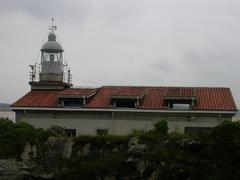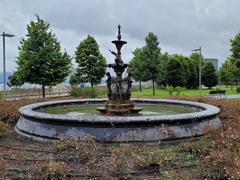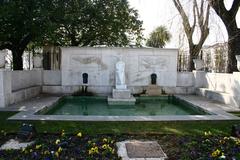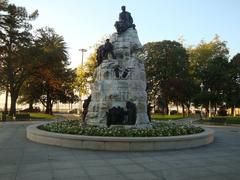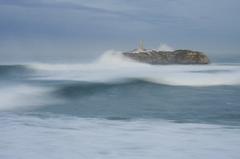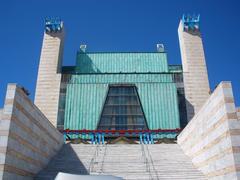Nave Sotoliva Santander Visiting Hours, Tickets, and Travel Guide
Date: 03/07/2025
Introduction
Nave Sotoliva, located in Santander’s historic port district, stands as a premier example of industrial heritage creatively transformed into a vibrant center for contemporary art and cultural innovation. Originally constructed in the mid-20th century as Spain’s largest oil packaging plant, the building’s robust architecture and industrial character have been preserved through a thoughtful, modern rehabilitation. Since its reopening in 2022, Nave Sotoliva has become a dynamic cultural hub, uniting Santander’s maritime past with cutting-edge artistic experimentation. Its accessible programming, free admission, and integration into the city’s revitalized waterfront make it a must-visit for art lovers, history enthusiasts, and travelers alike (Diario del Puerto, Diario El Canal).
This guide provides comprehensive information about Nave Sotoliva’s history, visiting hours, ticketing policies, accessibility, current exhibitions, and practical travel tips. It also highlights nearby historical sites and cultural attractions, equipping visitors for an enriching experience in Santander.
Table of Contents
- Introduction
- History and Transformation
- Contemporary Role and Exhibitions
- Visiting Information
- Nearby Historical and Cultural Sites
- Practical Travel Tips
- Frequently Asked Questions (FAQ)
- Visual and Media Resources
- Conclusion
- References
History and Transformation
Industrial Origins
Nave Sotoliva was originally part of a sprawling oil packaging facility, a centerpiece of Santander’s industrial economy in the mid-20th century. Its utilitarian design, featuring expansive open interiors and durable materials, was tailored for large-scale industrial operations (Diario del Puerto). Over time, shifts in the local economy led to the site’s decline and eventual closure.
Rehabilitation and Cultural Rebirth
Recognizing the building’s historical and architectural value, local authorities, in partnership with the Port Authority of Santander, undertook an ambitious rehabilitation project. Key features of the renovation included:
- Structural and Facility Upgrades: Robust repairs and state-of-the-art climate control to protect art and enhance visitor comfort
- Accessibility Improvements: Step-free entrances, ramps, and accessible restrooms
- Urban Integration: Enhanced pedestrian access, illuminated signage, and improved pavements along Calle Varadero (Diario El Canal)
Nave Sotoliva reopened in 2022 as a contemporary art venue, forming an integral part of Santander’s cultural ecosystem alongside the Palacete del Embarcadero and Faro de Cabo Mayor Art Center.
Contemporary Role and Exhibitions
Artistic Innovation
Today, Nave Sotoliva is known for its large-format sculptures, multimedia installations, and exhibitions by both emerging and established artists. The 2025 season includes solo shows by Lucía Simón Medina, José Luis Vicario, and Luna Bengoechea, exploring themes of sustainability, technology, maritime heritage, and ecology (Turismo de Cantabria).
Highlights include:
- “Diving Clouds” by Lucía Simón Medina: Marine environments via poetry, sculpture, and performance
- José Luis Vicario: Conceptual works on data extraction and resource exploitation
- Luna Bengoechea: Installations and photography on landscape transformation from ecological and feminist perspectives
These dynamic exhibitions are complemented by a robust program of artist talks, guided tours, and public engagement activities (Cultural Agenda, Puerto Santander).
Visiting Information
Hours and Admission
- Tuesday to Friday: 18:00 – 20:00
- Saturday: 11:00 – 14:00 & 18:00 – 20:00
- Sunday: 11:00 – 14:00
- Monday: Closed
Admission is free for all exhibitions and most events. Guided tours and select activities may require advance registration (Puerto de Santander).
Accessibility
Nave Sotoliva is fully accessible, offering:
- Step-free main entrance and ramps
- Accessible restrooms
- Wide, open-plan layout suitable for wheelchair users
- Clear signage and on-site assistance upon request
Recent upgrades also include energy-efficient climate control and improved lighting to ensure visitor comfort (Diario El Canal).
Guided Tours and Services
- Guided Tours: Led by curators or art professionals, providing in-depth insights into exhibitions and building history. Announced on the official website and social media.
- Cultural Mediation: Public programs include artist talks, catalog launches, and workshops.
- Information Desk: Staff available during opening hours for guidance and information (Puerto de Santander).
- Newsletter: Subscribe via email for the latest news.
Tips for Visitors
- Best Times: Weekday evenings and weekend mornings are usually quieter.
- Photography: Permitted for personal use, but check for restrictions during special exhibitions.
- Language: Information is primarily in Spanish, with some English translations.
- Family and Groups: Welcomes all ages; group/school visits can be arranged in advance.
Location and Directions
- Address: C/ Carlos Haya, 23A, 39009 Santander, Spain
- Public Transport: Bus lines 4 and 14 stop nearby; central train and bus stations are within a 15–20 minute walk
- By Car: Parking available in the port area (limited during peak times)
- By Foot: Easily walkable from city center and port attractions (Puerto de Santander)
Nearby Historical and Cultural Sites
Enhance your visit by exploring Santander’s rich heritage. Key attractions include:
- Santander Cathedral: Gothic church, open daily, free entry
- Palacio de la Magdalena: Historic royal palace (guided tours available)
- Museo de Prehistoria y Arqueología de Cantabria: Archaeological museum with free admission
- Palacete del Embarcadero: Waterfront exhibition space
- Centro de Arte Faro Cabo Mayor: Art center in a historic lighthouse
- Paseo de Pereda & Jardines de Pereda: Historic promenades and gardens
- Mercado del Este & Plaza Porticada: Local gastronomy and event spaces
For more details on hours, ticketing, and accessibility at these sites, visit local tourism portals (Tourist Platform, Turispanish).
Practical Travel Tips
- Transport: Santander is served by airport, rail, and ferry connections. The city’s compact size supports walking and cycling.
- Dining: No café on site, but numerous restaurants and cafés are nearby.
- Accessibility: Most cultural venues are equipped for visitors with mobility challenges.
- Tickets: Many museums offer online ticketing; city passes may be available.
- Weather: Spring and autumn are ideal for comfortable sightseeing.
Frequently Asked Questions (FAQ)
Is admission to Nave Sotoliva free?
Yes, entry to exhibitions is free. Some special events or tours may require registration.
Are guided tours available?
Yes, check the official website or contact staff for schedules.
Is Nave Sotoliva accessible for visitors with disabilities?
Yes, with step-free access, accessible restrooms, and on-site assistance.
Can I take photographs inside?
Photography is generally allowed for personal use, except during certain exhibitions.
What are the best ways to reach Nave Sotoliva?
By bus (lines 4 and 14), on foot from the city center, or by car (limited parking).
Visual and Media Resources
Enhance your visit by exploring:
- Virtual tours and exhibition images on the official website
- Social media galleries for up-to-date exhibition photos
- Alt-tagged images for SEO, such as “Nave Sotoliva visiting hours” and “Contemporary art exhibition in Santander”
- Video tours highlighting accessibility and current shows
Conclusion
Nave Sotoliva is a cornerstone of Santander’s cultural renaissance, linking the city’s industrial legacy with contemporary creativity and public engagement. With its free admission, accessible design, and dynamic exhibitions, it offers a welcoming space for all visitors. To maximize your cultural experience, check the latest schedules online, consider guided tours, and explore neighboring historical sites. Download the Audiala app for curated guides and updates, and immerse yourself in the best of Santander’s art and history (Puerto de Santander, Turismo de Cantabria).
References
- Nave Sotoliva de Santander mejora su sistema de climatización, 2023, Diario del Puerto (Diario del Puerto)
- Nave Sotoliva Santander, 2023, Diario El Canal (Diario El Canal)
- El agua arrastró a los dorados leones, 2025, Turismo de Cantabria (Turismo de Cantabria)
- Nave Sotoliva Exhibitions 2025, 2025, Turismo de Cantabria (Turismo de Cantabria)
- Cultural Agenda Puerto Santander, 2025, Puerto Santander (Cultural Agenda, Puerto Santander)
- Nave Sotoliva Official Website, 2025, Port Authority of Santander (Puerto de Santander)
- Visiting Santander’s Historical Sites, 2024, Tourist Platform (Tourist Platform)
- Santander Travel Guide, 2024, Turispanish (Turispanish)
